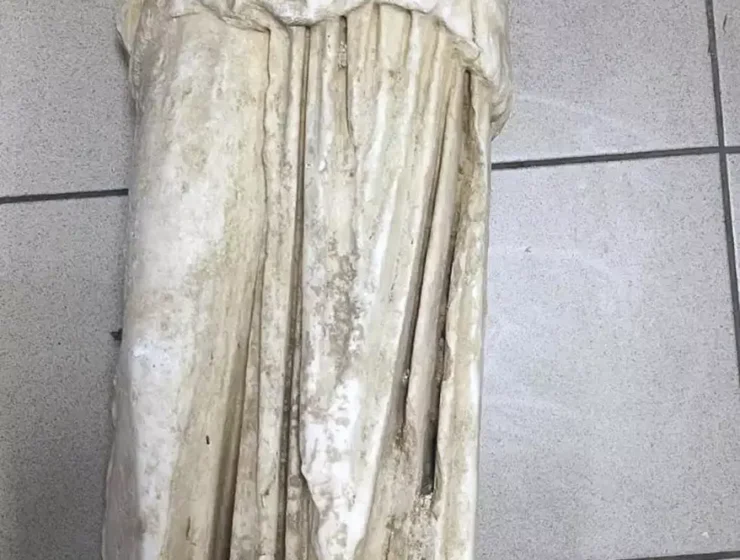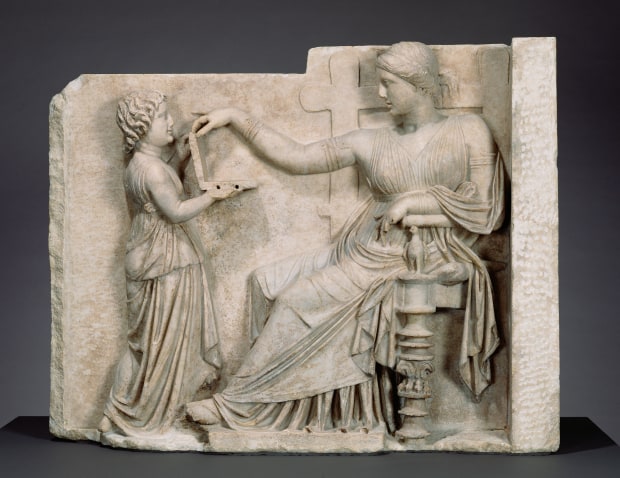Archaeologists in Turkey have unearthed around 2,000 pieces of bronze statues in an ancient scrapyard in Metropolis, now known as Izmir. This discovery highlights the early recycling practices of the Late Antiquity period, revealing a treasure trove of disassembled bronze parts likely intended for reuse.
Tag: archaeological discovery
A Hellenistic-era statue was unexpectedly discovered in a garbage bag near a trash container in Thessaloniki, Greece, prompting an investigation into its origins.
An ancient Greek statue of a woman seemingly using a laptop has sparked online theories…
A 1,500-year-old Byzantine-era monastery has been discovered in southern Israel, featuring a remarkable mosaic with an ancient Greek inscription from the Book of Deuteronomy. Uncovered near Kiryat Gat, the site reveals the region's rich historical significance and includes vibrant images and structures dating back to the Roman and Byzantine periods.
A team of archaeologists from the University of Haifa recently uncovered a rare treasure of over 160 ancient coins in the Jordan Valley, dating back to the Asmonean period over 2,100 years ago. Discovered near the ancient Fortress of Alexandria, the coins feature inscriptions in both Aramaic and Greek, including the name of King Alexander Jannaeus. The find, made during the Jewish festival of Hanukkah, provides a unique glimpse into the region's history and is one of the largest coin collections ever found in the Holy Land.
Archaeologists in Turkey have uncovered a depiction of the Greek goddess Hecate in a 3,000-year-old temple complex in Mugla province. The discovery at Lagina, an ancient Greek town, reveals new insights into the cult of Hecate and the rituals performed by pilgrims. The find includes a Hecate torch motif on a column and Corinthian capitals from the Hellenistic and Roman periods, offering a glimpse into ancient religious practices.
A hidden trove of ancient artifacts, dating from Greece's Geometric period (1100-750 BC) to the Hellenistic era (up to 31 BC), was discovered in a vacated Athens store earlier this year. The cache, packed in boxes wrapped with 1940s newspapers, included over 3,000 items, ranging from ancient coins and vessels to post-Byzantine religious artifacts. The find highlights Athens' rich historical layers and underscores the importance of preserving and studying cultural heritage.
Archaeologists in Tuscany have uncovered a remarkable collection of ancient artifacts at the thermal springs of San Casciano dei Bagni, including statues, coins, jewelry, and intact eggs from the Roman and Etruscan eras. Among the finds is a large bronze statue believed to depict Agathodaemon, a protective deity from Greek mythology. These treasures, preserved by the warm mud of the springs, will be displayed in a new museum opening in 2026.
During the construction of Athens' new Metro Line 4, archaeologists have uncovered a 22-meter section of an ancient road from the 4th century BCE at the University of Athens campus. With plans for its preservation and future relocation, this find offers insights into the historical Potamos municipality near Mount Ymittos.
An archaeological dig in Palaepaphos has revealed an intriguing inscription of ancient Cypriot writing on a wall from the 6th century BC. This discovery, made in the Kouklia-Martsello area, has drawn considerable interest, potentially shedding light on the site's historical significance. Recent excavations have shifted focus from the site’s once-presumed defensive role to a more devotional purpose, sparking new theories about its past.
During the construction of a water pipeline on the Greek island of Euboea, workers uncovered a stunning 2,400-year-old mosaic depicting dancing satyrs. This artwork, dating back to the mid-fourth century BCE, features two mythical figures playing music and dancing, offering a fascinating glimpse into ancient Greek culture and artistic expression. The mosaic was found in Eretria, an ancient town on Euboea, and is in exceptional condition. To protect the site, construction has been rerouted, and the mosaic is now covered for preservation.
A gold plaque inscribed with Greek letters has been discovered at the ancient Apsaros Fortress in Georgia, offering new insights into the religious practices of Roman soldiers. The plaque, believed to be an offering to the war god Jupiter Dolichenus, strengthens evidence that the fortress was located near a temple dedicated to this deity. Archaeologists believe the soldiers may have left the offering seeking divine favor in battle, reflecting the widespread veneration of Jupiter Dolichenus across the Roman Empire.
In a rare discovery, archaeologists have unearthed a remarkably preserved house in ancient Pompeii adorned with frescoes of Greek mythological scenes, untouched since the catastrophic eruption of Mount Vesuvius nearly 2,000 years ago.
Archaeologists have uncovered a rare gate sanctuary at the Minoan palace of Archanes in Crete, the first of its kind found at a Minoan site. Led by Efi Sapouna-Sakellaraki, the excavation revealed altars, religious artifacts, and Mycenaean-era remnants, offering new insights into the palace’s historical and religious significance.
A 6th-century Byzantine basilica was discovered in Oreoi, northern Evia, during recent excavations for a sewage system. The find includes the church’s foundation, apse, and brick-lined floor, along with artifacts such as iron crosses and a bronze lamp ring. This significant discovery sheds light on the religious history of the region, once part of the diocese under the Metropolis of Corinth.
Archaeologists have uncovered a remarkable 2,400-year-old Greek theater at the ancient site of Alexandria Troas in Turkey. This impressive structure, believed to seat between 10,000 and 12,000 spectators, adds to the region's rich archaeological heritage, which includes the legendary city of Troy. The ongoing excavations are led by Erhan Oztepe from Ankara University, with support from Turkey’s Ministry of Culture and Tourism.
Archaeologists have uncovered the remains of a luxury Roman village in southeastern Sicily, near Vizzini, featuring a mosaic floor from the 2nd to 4th centuries AD. Led by Johannes Bergemann, the team used geophysical surveys to locate the site, revealing a spacious Roman house and other comparable structures. The findings highlight the high standard of living during this period and the region's transition from ancient Greek cities to Roman rural settlements. The team presented their discoveries at Vizzini Town Hall and will further share their findings at the University of Göttingen in February 2025.
Catalan archaeologists have unearthed a 6th-century B.C. jug at Empúries, featuring scenes of a palestra. Found in one of the site's earliest homes, the jug offers insight into the ancient Greek practice of placing such offerings during construction. Pere Castanyer notes that this tradition mirrors modern practices, like placing newspapers or coins under the first brick of a new house.
Two ancient statues of Greek deities, Cybele and Selene, were discovered in 1998 embedded in a Byzantine-era wall. Now restored, these statues are on display at the Acropolis Museum, offering a glimpse into ancient Greece's spiritual life.
rchaeologists have unearthed a chilling discovery in Corinth, Greece, revealing a 1,600-year-old Roman prison with haunting graffiti inscribed on the prison floor, offering a rare glimpse into the harsh conditions faced by prisoners.




















